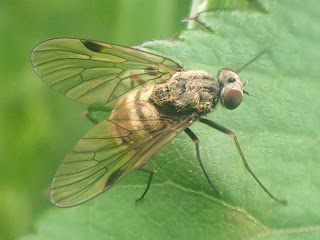Wednesday 29th May 2024, Telford Town Park
After the previous Wednesday’s downpours that led to the cancellation of the scheduled trip, the weather was better behaved for our outing to Telford Town Park. The day started with a short, light sprinkle, followed about 20 minutes later by a short burst of heavy rain. After this, apart from a few spits and spots, the rain stayed away.
Telford Town Park is a large site close to the centre of Telford. It consists of a collection of habitats including meadow, amenity grassland, wet meadow, woodland, scrub, pools, streams, ditches and areas of archaeological interest. Much of the park is designated as a Local Nature Reserve.
.
We parked towards the south of the site close to Grange Pool (where parking is free).
Being a local site for me, I managed to arrive about 15 minutes before the scheduled start to find two others already there and scouring the area around the car park for items of interest.
When the rest of the attendees had arrived and kitted themselves out, we set off for our initial target area, a large meadow. As far as I know it has not been named but it does have an owl box standing proud in one corner, just discernible in the following photograph.
We made rapid progress and as we arrived, having negotiated a rather tricky muddy path to get there, a short burst of heavy rain also arrived.
Some sought shelter under the trees, others just donned waterproofs and toughed it out.
Thankfully, the rain soon stopped, and we got down to “work”.
A very early find and a hope of new life, was a clutch of eggs.
 |
| Photograph: David Williams |
We knew they were probably shieldbug eggs, but which one's. I should know but I could not place them! Fortunately, use of a smart phone allowed us to determine they were the eggs of a Bronze shieldbug.
Very much adults were this long-horned moth, Nemophora degeerella;
 |
| Photograph: Neil Nash |
And planthopper, Thamnotettix confinis.
 |
| Photograph: John Lyden |
The meadow was very wet underfoot. Those of us not wearing wellingtons needed to watch where we placed our feet lest we end up with a boot full of water.
But flourishing above the water level was an orchid.
More signs of new life. This time more advanced than eggs. A couple of moth larvae. I believe they are both Noctuid species but I have not been able to determine which.
 |
| Photograph: Nigel Cane-Honeysett |
 |
| Photograph: Nigel Cane-Honeysett |
Continuing the theme of new life we found the larva of a Cream-spot ladybird.
 |
| Photograph: David Williams |
New life and the creature that probably created it. A tiny spider, Paidiscura pallens, and its sputnik-shaped egg sac that is larger than the spider!
 |
| Photograph: Nigel Cane-Honeysett |
It was lunchtime, but the meadow was far too wet to find a suitable place to have it. We moved on to our second target area, another meadow, much smaller, by Fletcher’s Pool.
This meadow was just as wet as the first, but the ground did rise in one corner. This area was drier and suitable for our lunchtime picnic.
Lunch over, we carried on where we had left off. An early after lunch find was a snipe fly, Chrysopilus cristatus.
 |
| Photograph: John Lyden |
Back to our theme of new life the nymph of an Oak bush cricket was discovered.
 |
| Photograph: David Williams |
The remaining couple of finds that were photographed were both adults.
Despite its appearance this is a 10-spot ladybird. This species has several different forms and this is, surprise, surprise, the two-spotted one.
 |
| Photograph: Nigel Cane-Honeysett |
A red and black hopper, Cercopis vulnerata.
 |
| Photograph: David Williams |
We left the meadow and wandered along a very muddy path through some woodland. Passing over, then beside, a stream we noticed some figwort. And on the figwort a couple of weevils were having a staring match.
 |
| Photograph: David Williams |
This delightfully liveried weevil, Cionus tuberculosus, is associated with figwort, so both were in the right place!
Emerging from the woodland we found ourselves close to the Stirchley Chimney. We spent the rest of the afternoon in that area accompanied by the sound of a powered lawnmower and strimmer. They easily drowned out the noise made by our suction samplers.
Things of interest that we found in the grassland, rougher vegetation, bushes and trees in this area included:
A digger wasp, an Ectemnius species;
 |
| Photograph: Neil Nash |
A fly, Empis livida;
 |
| Photograph: Nigel Cane-Honeysett |
Another youngster, this time a Speckled bush cricket;
 |
| Photograph: David Williams |
A rove beetle, as yet unidentified;
 |
| Photograph: Nigel Cane-Honeysett |
A Tortoise shieldbug;
 |
| Photograph: David Williams |
And to complete our collection of new life, an egg sac being carried around by a Nursery-web spider.
 |
| Photograph: Nigel Cane-Honeysett |
And with that, we went home.
My thanks to Telford and Wrekin Council for granting us permission to play and to the photographers for providing their excellent images for this report.
.JPG)
.JPG)



























No comments:
Post a Comment
Please feel free to comment on this post...